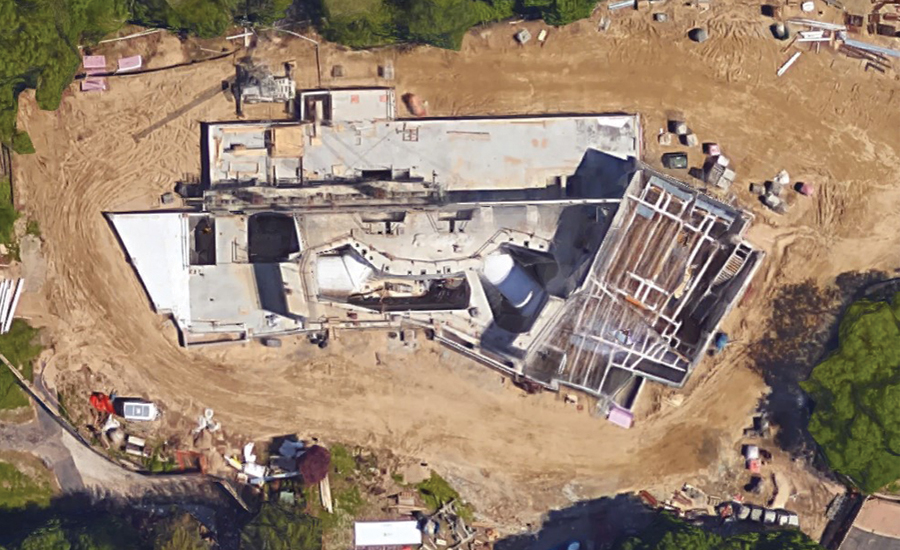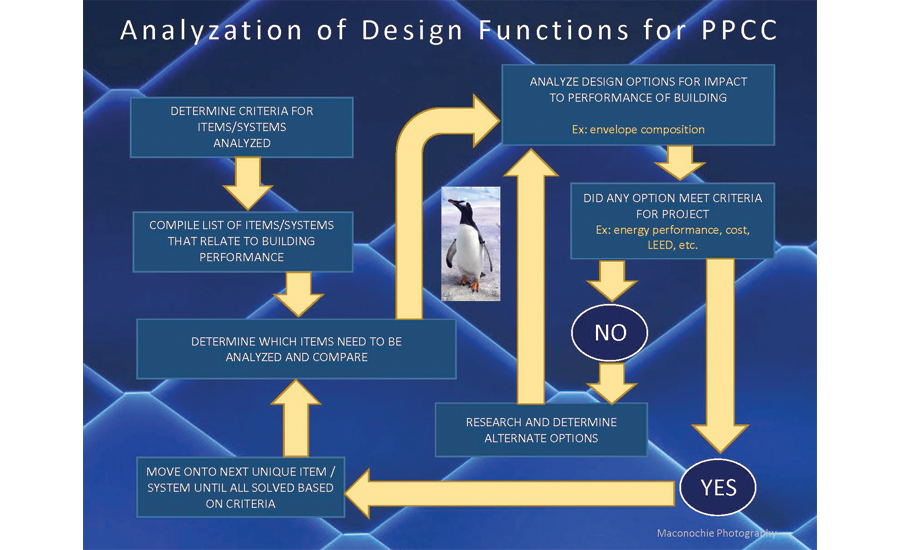High-Performance Building Enclosure Design for a Net-Zero Ready Habitat for Sub-Zero Wildlife
Polk Penguin Conservation Center—A Case Study
A very unique building, the PPCC was designed to house two wildly different and distinct environments, an Antarctic climate for penguins and a temperate climate for humans. A popular attraction, visitors get timed-tickets to enter the exhibit. Zoo officials have planned for nearly 1,000 visitors per hour at peak times. It also provides work and animal husbandry areas for the staff who care for the birds. The center incorporates many high-performance design elements.
Designed Green—Non-Enclosure Elements
In addition to the enclosure, many green and sustainable design features are incorporated into the penguin center:
LEED Gold Criteria
The building was designed to achieve LEED Gold criteria and standards, but the client decided not to apply. Although LEED certification is not required to be a high-performance building, many LEED design features such as energy use, sustainability and siting were incorporated. But LEED wasn’t the only green design criteria used.
Net-Zero Ready
A Net-Zero Building “is an energy-efficient building where, on a source energy basis, the actual annual delivered energy is less than or equal to the on-site renewable exported energy” (Office of Energy Efficiency & Renewable Energy, 2015). The PPCC was designed to be Net-Zero ready. Originally planned to use solar panels and a geothermal system, they will be added once funds are procured. Other related systems and features currently included are:
- Energy loads for the mechanical and electrical systems were limited.
- All lights are LEDs, except a few in the animal habitat areas where the wave length from white LED light is not acceptable for a healthy penguin environment. Here metal halide lamps were used to simulate Antarctic daylighting producing 14,000 kelvin temperature over the water and 10,000 kelvin temperature over the land mass. Red 660 nanometer night lights were used for night time monitoring of space.
- Energy recovery wheels capture heat/energy from the mechanical systems and reduce energy consumption. This allows the center to use a small condensing hydronic boiler to provide supplemental heat as required. It is designed to operate most efficiently in systems with low return-water temperatures—achieving efficiencies up to 99 percent (Lobell, Spring 2016).
- CO2 and occupancy sensors in staff and public spaces are used to avoid unnecessary conditioning of air and limit ventilation to reduce energy use.
- Daylighting control systems monitor sunlight entering through the solar tubes and windows to limit the amount of lights used depending on daylight conditions and time of day.
Other sustainable, non-enclosure design elements of the PPCC include:
- Low volatile organic compound finishes and adhesives to limit off-gassing and promote healthier air quality.
- Materials made regionally and materials with recycled content to reduce the overall embodied carbon footprint of the building.
- Reclaimed wood on exhibit panels simulate the ship’s hull, not only appearing more authentic, but it’s also reuse of a perfectly good material instead of sending it to a landfill.
- A unique UV filter system to treat and reuse the penguin pool water, which allows a closed loop system without the need to add water—one of only three being used in the U.S.
Designed for the Future
This project relied entirely on donations for funding, and not all green elements the Detroit Zoo wanted to include were built. But design features are in place to add these energy-saving and green features once funds are available. The PPCC was designed to incorporate geothermal and solar systems. Also, a natural water filtration system will be added. Currently, 100 percent of the penguin pool water is filtered, but the Zoo wants all the water in the building filtered. Under construction is a solid-based anaerobic digester that will take animal wastes from the entire Detroit Zoo and capture methane gas produced, which will be used in an electric generator as an energy source. The leftover solids will then be used as class “A” fertilizer, or “Zoo Poo.” This will be the first system of its kind to be used for a zoo in North America, and one of a very few in the world.

Photo courtesy of Albert Kahn Associates Inc.
Under construction, in the middle of the building is the two-level exhibition space. To the left (west) is the lobby and gift shop, and to the right (east) is the ramp that leads to the lower level. To the back (north) is staff facilities. Site orientation is an important passive design element that will help control heat gain.
Passive Design Elements—Key to the Enclosure Design
Passive design is at the heart of the enclosure’s design, and it’s important to use as many passive elements as possible when designing a complex building. Passive design is “using the sun’s energy for heating and cooling of living spaces. In this approach, the building itself or some elements of it takes advantage of natural energy characteristics in materials and air created by exposure to the sun” (Passive Solar, 2016). Basically, passive design limits heat gain in summer and/or amplifies heat gain in the winter. It is using elements that are not mechanical in nature, but are incorporated into the structure and will last for the life of the building. For the most part, these design elements are not associated with operational costs and have limited maintenance costs. Examples of passive design are:
- Building orientation
- Daylighting and light shelves
- Shading and sunscreens
- Window placement and size
- Glazing type and thickness
- Thermal insulation and mass (such as walls or building into the earth)
- Natural ventilation including stratification
All these passive design elements can be used within the building to limit the amount of mechanical heating and cooling necessary to make the building comfortable for the user. The PPCC incorporates many of these passive design elements to create the enclosure. In keeping with the Zoo’s directive to prioritize the penguin’s health and environment, the design was driven by the necessity to keep the penguin’s habitat cool.
Fondly referred to as a 33,000-square-foot refrigerator by the design team, the uniquely shaped building and roof are white. The design form is an abstraction of the Antarctic landscape and is inspired by tabular icebergs. White is highly reflective and helps keep the penguin habitat cool. Also, the building was sited to minimize the heating effect of the summer sun. The building shape itself shades sunlight during the summer and maximizes the solar penetration during the winter. In addition:
- Extra insulation was used in the exterior walls. Underground walls have about R11. Above ground walls have R37 for the metal, R15 for the mass and about R45 for the roof.
- Exterior windows were limited to a total of 2,155 square-feet for the entire building, including the skylights on the roof. Glazing was limited to locations where it’s necessary in the vestibules, the offices on the north side, and limited glazing into the animal habitat. The majority of the glazing has some shading elements to limit the amount of solar heat gain entering the building.
- A rainscreen exterior wall composition minimizes the amount of the building’s heat gain on the western, eastern and southern faces.
Key to successfully melding these passive designs with the other energy-saving elements is using a thorough and exacting design process.
The Design Process
When designing a building that has unique functions and multiple environments, the first thing you must do is realize, comprehend and focus on the concept that all are interrelated and affect each other. The project team must understand the design goals whether they be cost, meeting a certification like LEED, schedule, occupant health or others. As the design progresses, one should analyze/model the impact of the building’s performance for all functions. It’s easier to analyze by taking one system/material/function at a time and reviewing their various options and their impact on energy use. As shown in the accompanying flow diagram, based on the results the team will adjust the design, selection of systems, materials and details accordingly. Then they reanalyze the adjusted design to see how the building will function. The team must repeat adjusting the design and reanalyzing for building functions until the design successfully meets all unique function criteria.
For the PPCC, it was important to look at the energy modeling and ask questions such as, “What would happen if we changed the envelope to another specific type? Or “What if we increased the overhangs? How would this effect the amount of heat gain or heat loss of the overall building enclosure?” This process is repeated until a satisfactory design is reached. This will take additional time compared to designing to only meet code. Be careful, because this can turn into countless hours with diminished potential energy savings. There is no hard fast rule on how much additional time this will take; it will depend on what you are analyzing and the size and complexity of the project.

Illustration courtesy of Albert Kahn Associates Inc.
To achieve a successful design, the design process must be fluid. The project team evaluate options, model for effectiveness, and then redesign until the design meets all unique project criteria.









